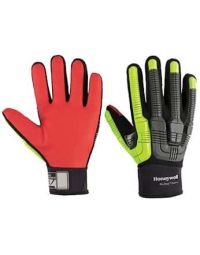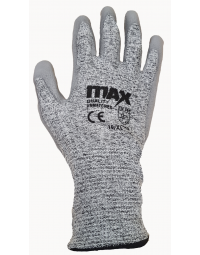Many tasks require gloves to be cut-resistant, but how do you know which level of cut resistance you need for the task you are carrying out?
US and European industry standards have taken the guesswork out of choosing the right gloves, but it helps to understand the markings on cut-resistant gloves to make sure you get the appropriate level of protection.
In this blog post, we will show you how to read the cut resistance ratings of both US and European standards.
Cut Resistance Standards: America
ANSI/ISEA 105, set by the American National Standards Institute (ANSI) and the International Safety Equipment Association (ISEA), offers nine levels of cut resistance, each indicating how many grams of cutting force from a sharp blade the glove can bear before it is penetrated.
The lowest rating is A1, which means the glove can withstand a cutting force of 200-499g. For A2 and A3 ratings, these readings increase in increments of 500 grams (500-999g and 1000-1499g respectively).
An A4-rated glove will withstand a cutting force of 1500-2199g, while an A5-rated glove will be suitable for forces of 220-2999g.
The next three ratings (A6, A7 and A8) increase in increments of 1000g, giving cut resistances of 3000-3999g, 4000-499g and 5000-5999g. The highest rating A9 is suitable for cutting forces above 6000g.
Cut-resistant gloves that meet ANSI/ISEA specifications will be marked with a shield-like symbol that displays the rating:

Cut Resistance Standards: Europe
EN 388 is the standard set by the European Commission for glove cut resistance. This is a more complex standard than ANSI/ISEA 105 which comprises two cut resistance tests. The first of these is the TDM-100 Test, which uses a similar method to ANSI.
EN388 TDM-100 Cut Resistance Test
This test uses a similar method to the ANSI/ISEA test but has only six ratings and is measured in Newtons.
An A-rated glove will resist a cutting force of 2.0-4.9N (204-508g). the cut resistance of B- and C-rated gloves then increases in 5N increments, giving 5.0-9.9N (509-1019g) and 10.0-14.9N (1020-1529g) respectively.
As with the ANSI/ISEA test, the next two ratings increase in higher increments. D-rated gloves will resist a 15.0-21.9N (1530-2242g) cutting force, while E-rated gloves are suitable for a cutting force of 22.0-29.9N (2243-3058g).
The highest TDM-100 rating is F, with a cutting resistance exceeding 30.0N (3059g).
EN388 Coup Test
The second test is called the Coup Test. This uses a ratio, called the ‘cut index’, which compares the glove material’s cut resistance to that of cotton fabric. It uses an oscillating circular blade running at a constant speed to measure the force required to cut through the material.
There is a major drawback with the Coup Test, however: some materials used to test the cut resistance can dull the blade, affecting the accuracy of the ratings. Because of this, some European-rated gloves may only show the TDM rating.
This is an example of an EN388-rated glove marking.

The first information this gives us is that it is an EN388-certified product. Below the shield, we have a series of numbers and letters. In this example
· The first number (3) shows us the abrasion rating
· The first letter (X) is the Coup Test result: an X tells us that there is no result
· The second number (4) is the tear rating
· The third number (4) is the puncture rating
· The second letter (D) is the TDM-100 cut rating
· The last letter (P) shows the glove qualified in a pass/fail impact protection test
How do you choose the right level of glove cut resistance?
It would be simple to say that the safest option would be to always use gloves with the highest level of cut resistance, but these gloves typically offer added protection at the expense of comfort, dexterity and sensitivity.
Probably the best way to choose gloves is to split these into light, medium and heavy duty.
Cut-resistant gloves for light-duty work
Where there is a lower risk of cuts or punctures and any potential injuries would be minor, a light-duty cut-resistant glove offers greater comfort and agility.
Examples of industries where a light-duty glove might be suitable include working with glass, catering and food processing, light sheet metal work and some electrical.
For gloves that provide light-duty cut resistance, look for an ANSI cut level of A1 to A3 or an EN388 cut level of A to B. Matrix Orange Seamless Gloves from CMT have an A3 cut resistance rating.
Cut-resistant gloves for medium-duty work
When handling materials that present a higher risk of cut injury, look for gloves that have an ANSI rating of A3 to A5 or an EN388 rating of C to E.
Examples of medium-duty work include home maintenance, electrical and working in recycling or salvage.
With a cut resistance rating of C, Max Cut Resistant Gloves from CMT Group are suitable for this kind of work.
Cut-resistant gloves for heavy-duty work
If your work carries a high risk of cuts and lacerations, look for an ANSI cut resistance level of at least A5 or an EN388 rating of E to F.
These will be suitable for occupations such as mining, rescue, heavy construction and ironworks.
One example of a cut-resistant glove for heavy-duty work is the Rig Dog Xtreme from CMT Group, which has a cut resistance rating of F.
Who can help you choose the right cut-resistant gloves?
If you’re still uncertain about the best cut-resistant gloves for your work, contact the friendly, knowledgeable advisers at CMT Group by calling 020 8311 1144, emailing sales@cmt.co.uk or using the online live chat on our contact page.



